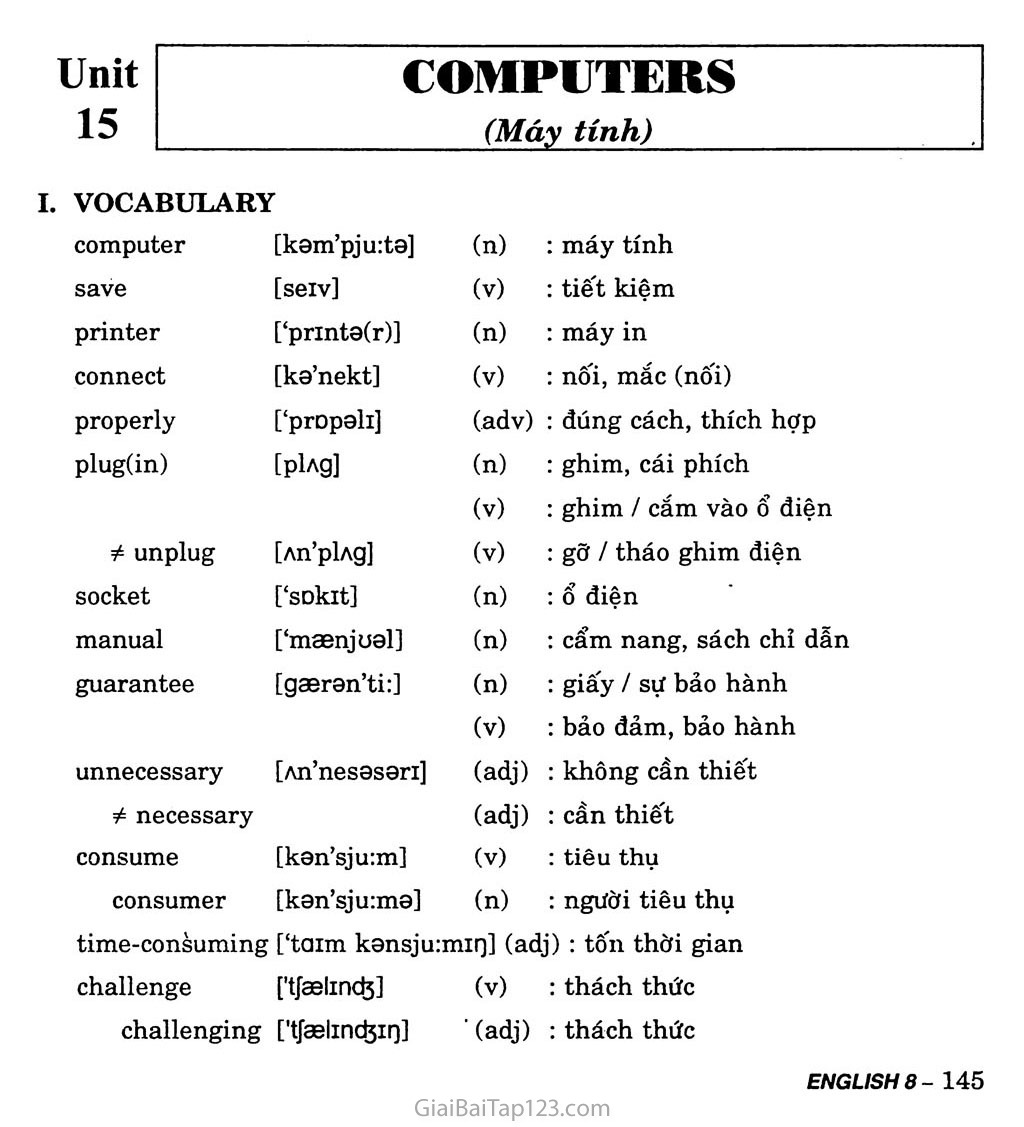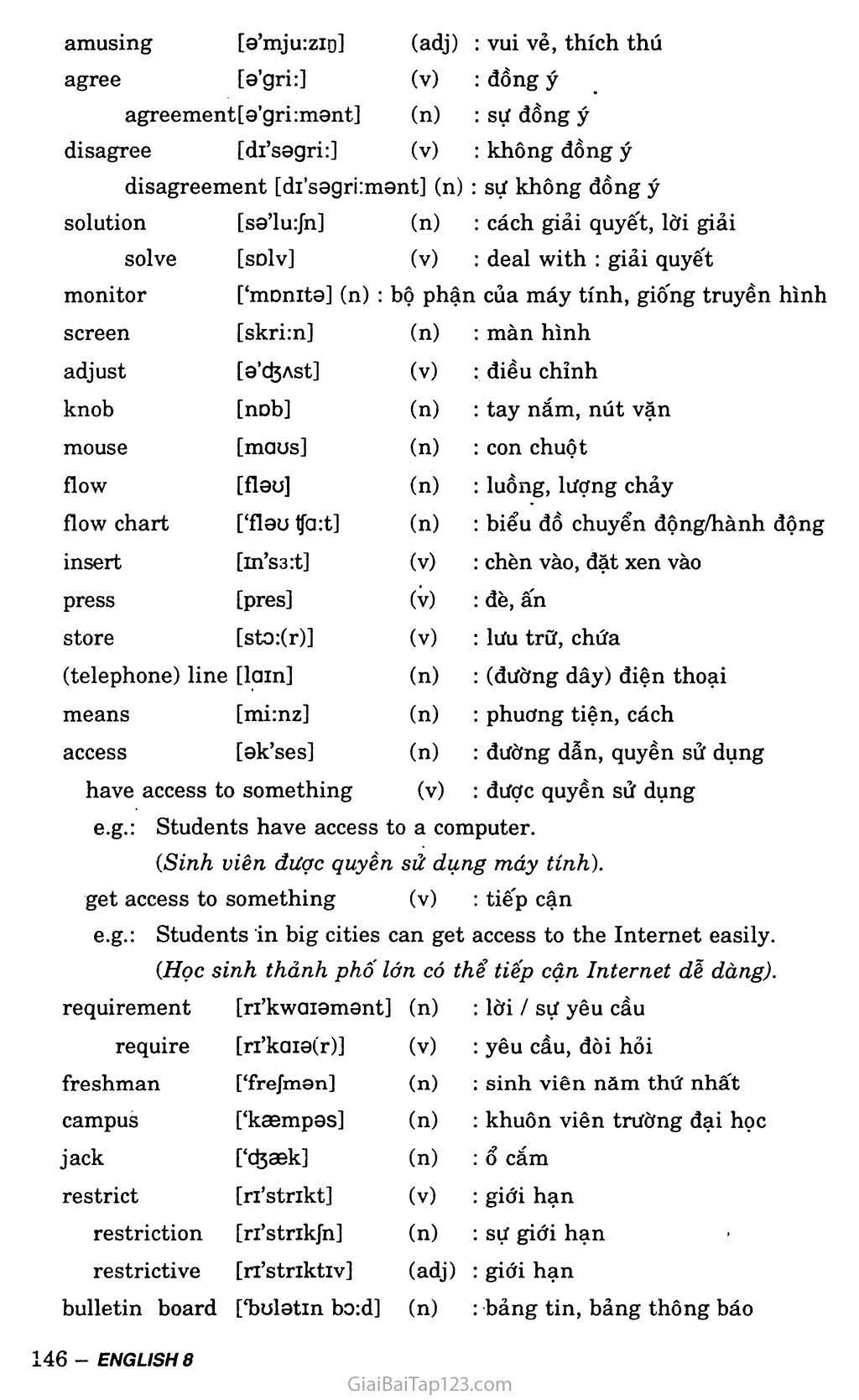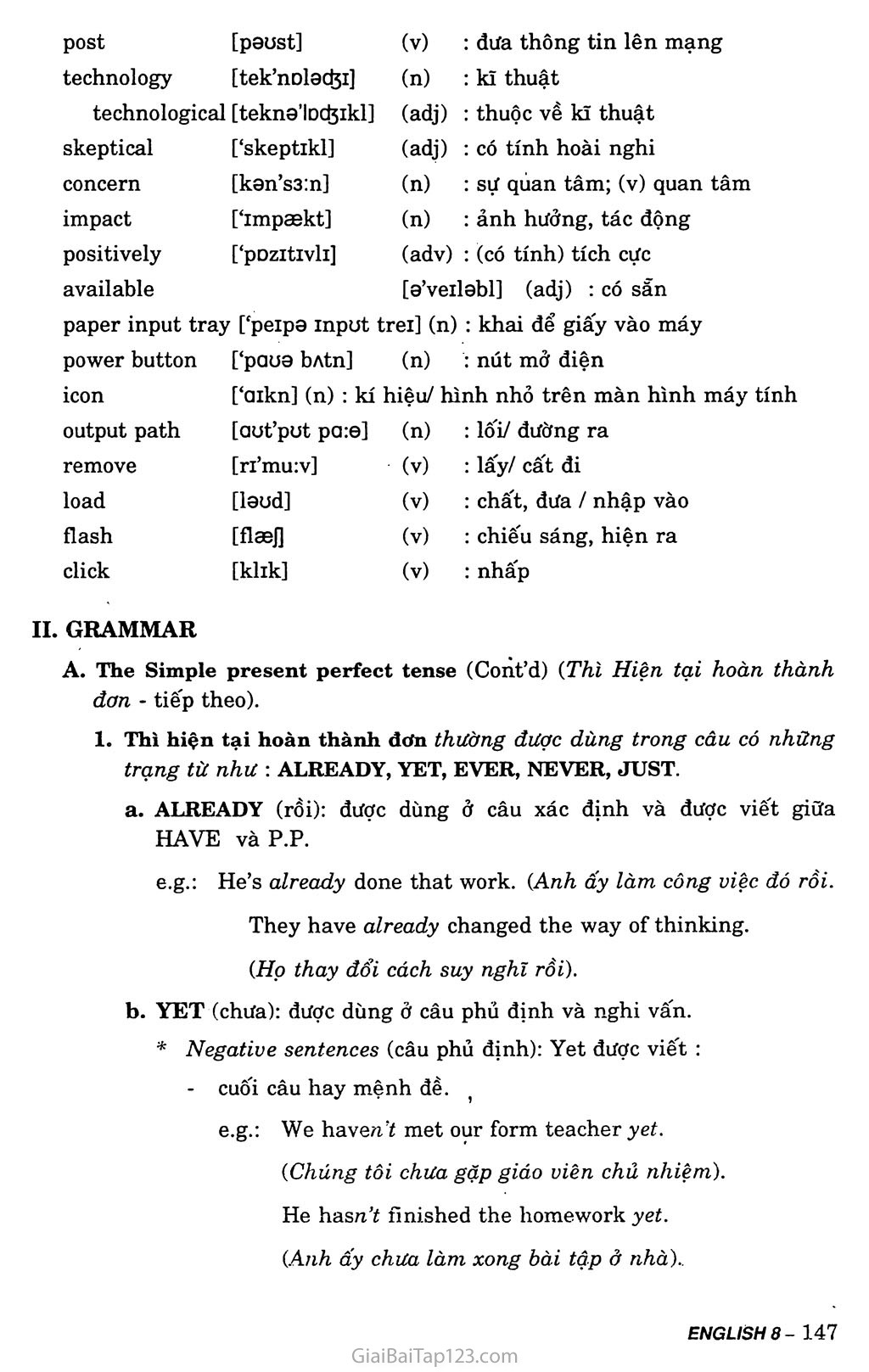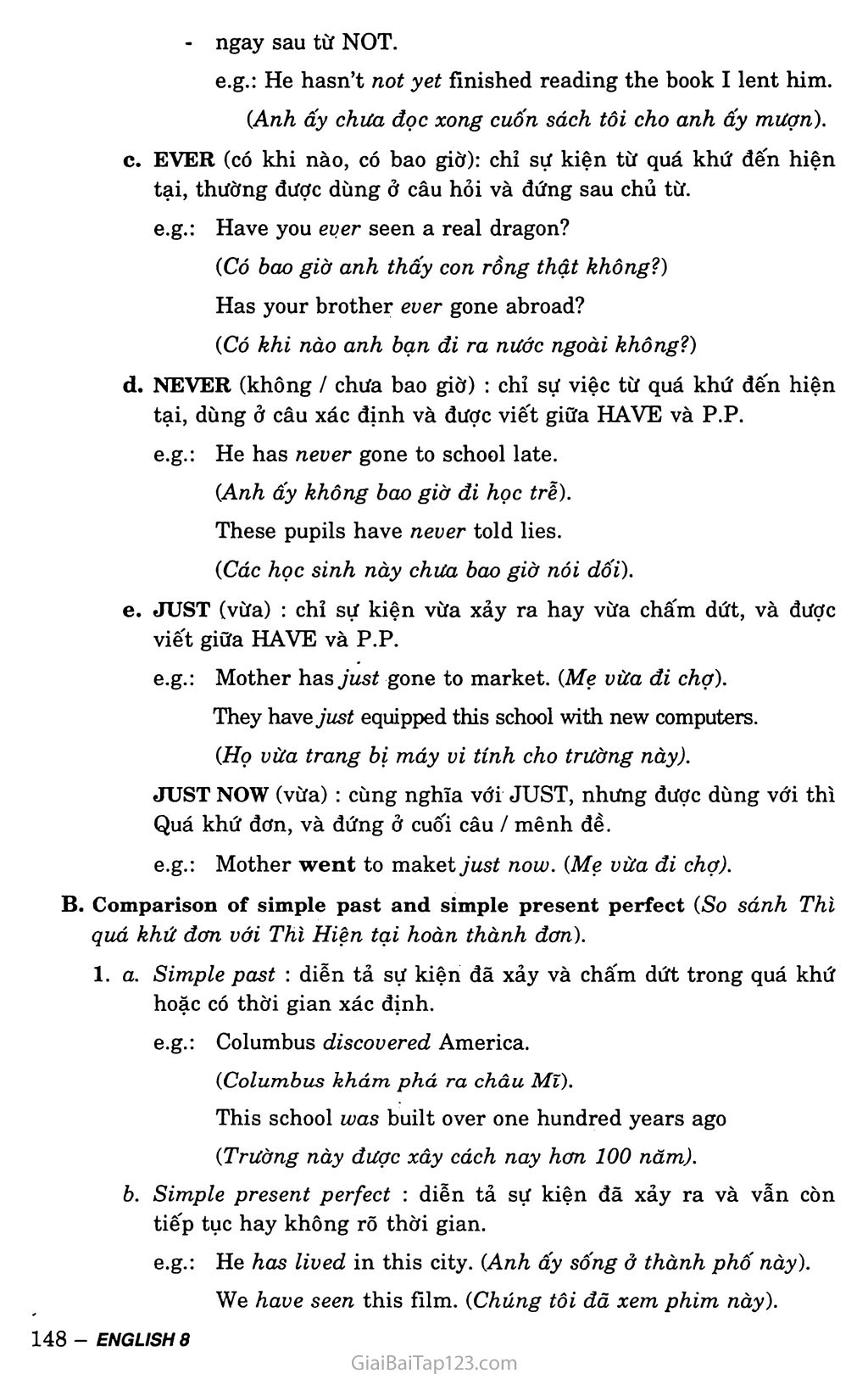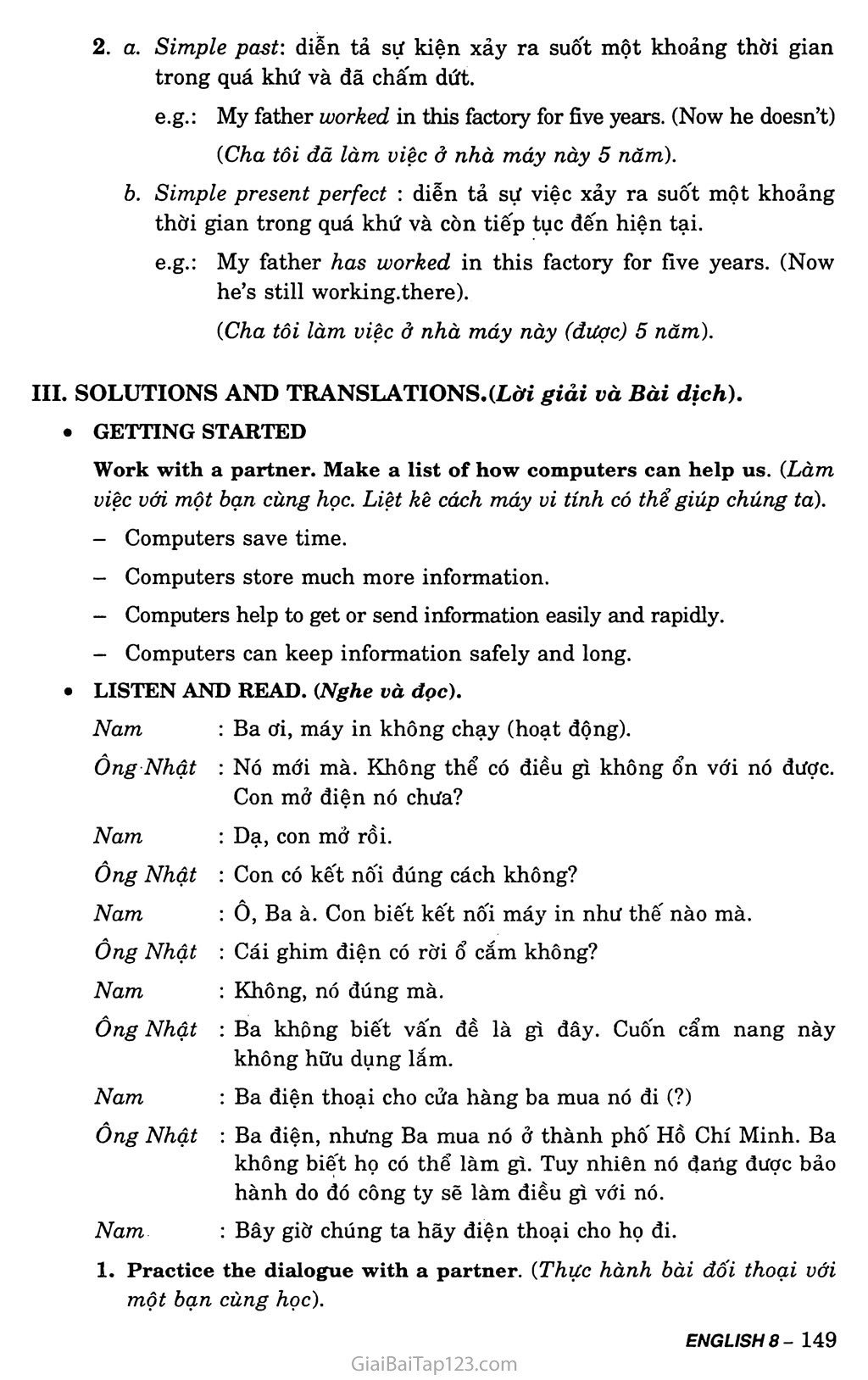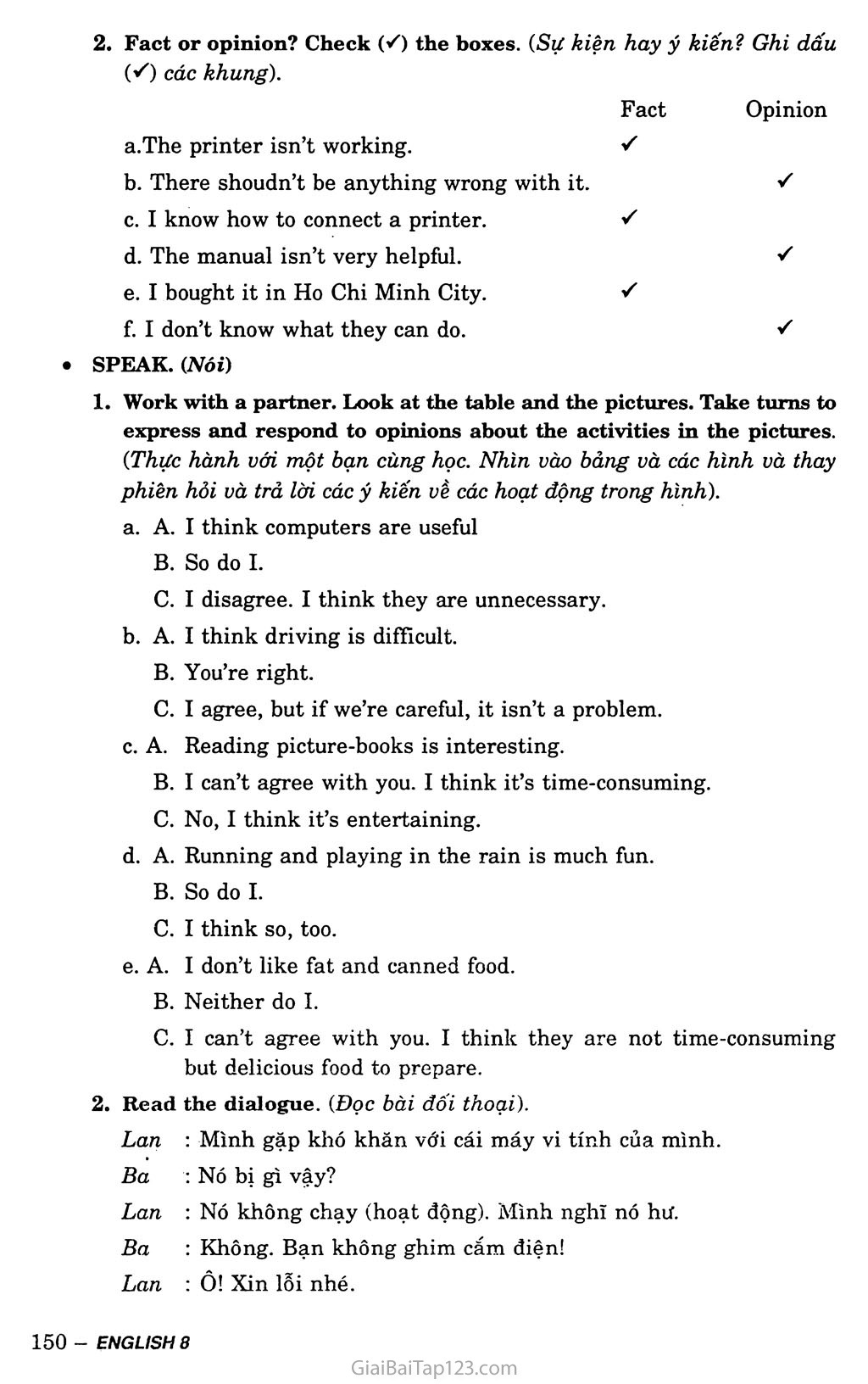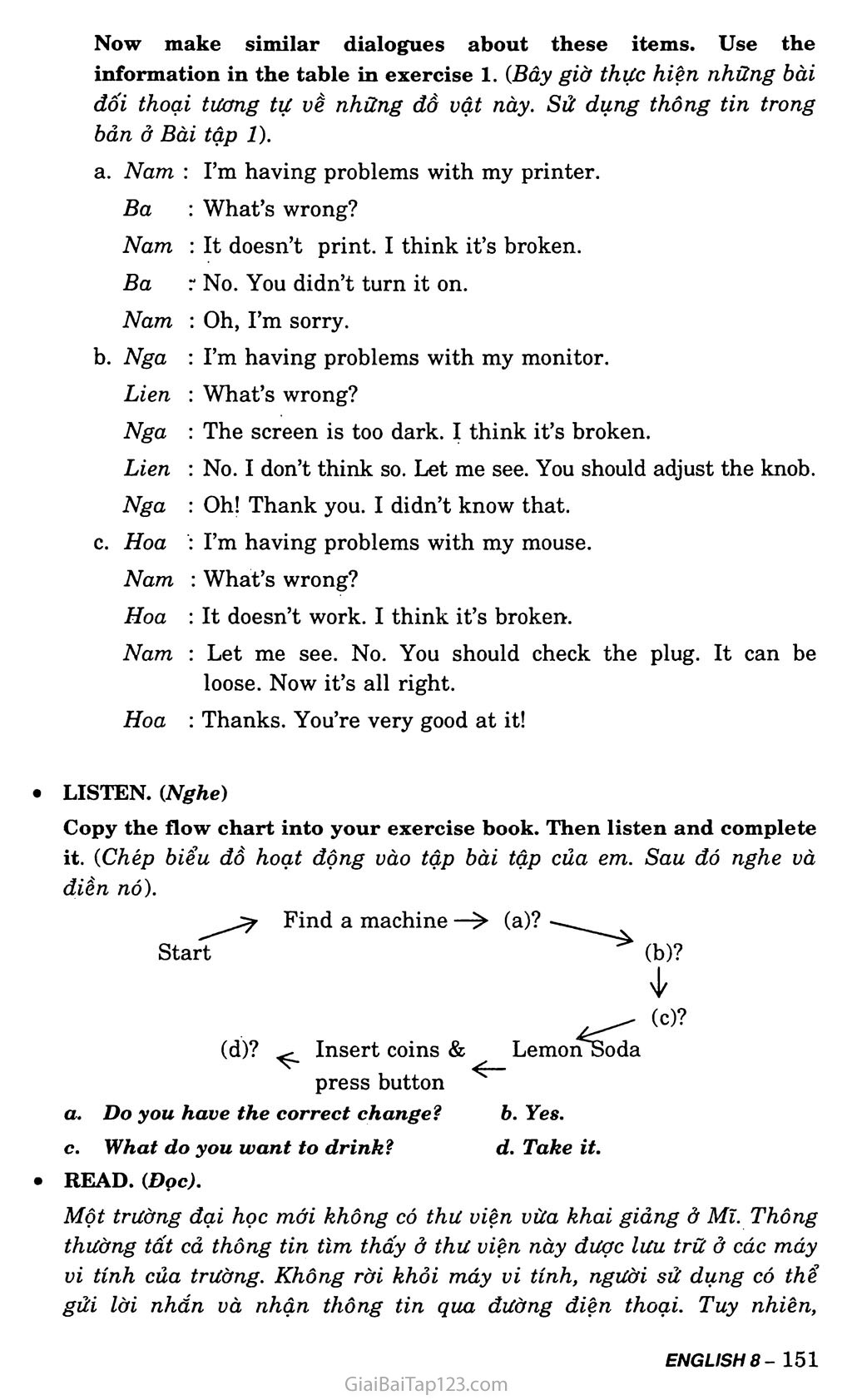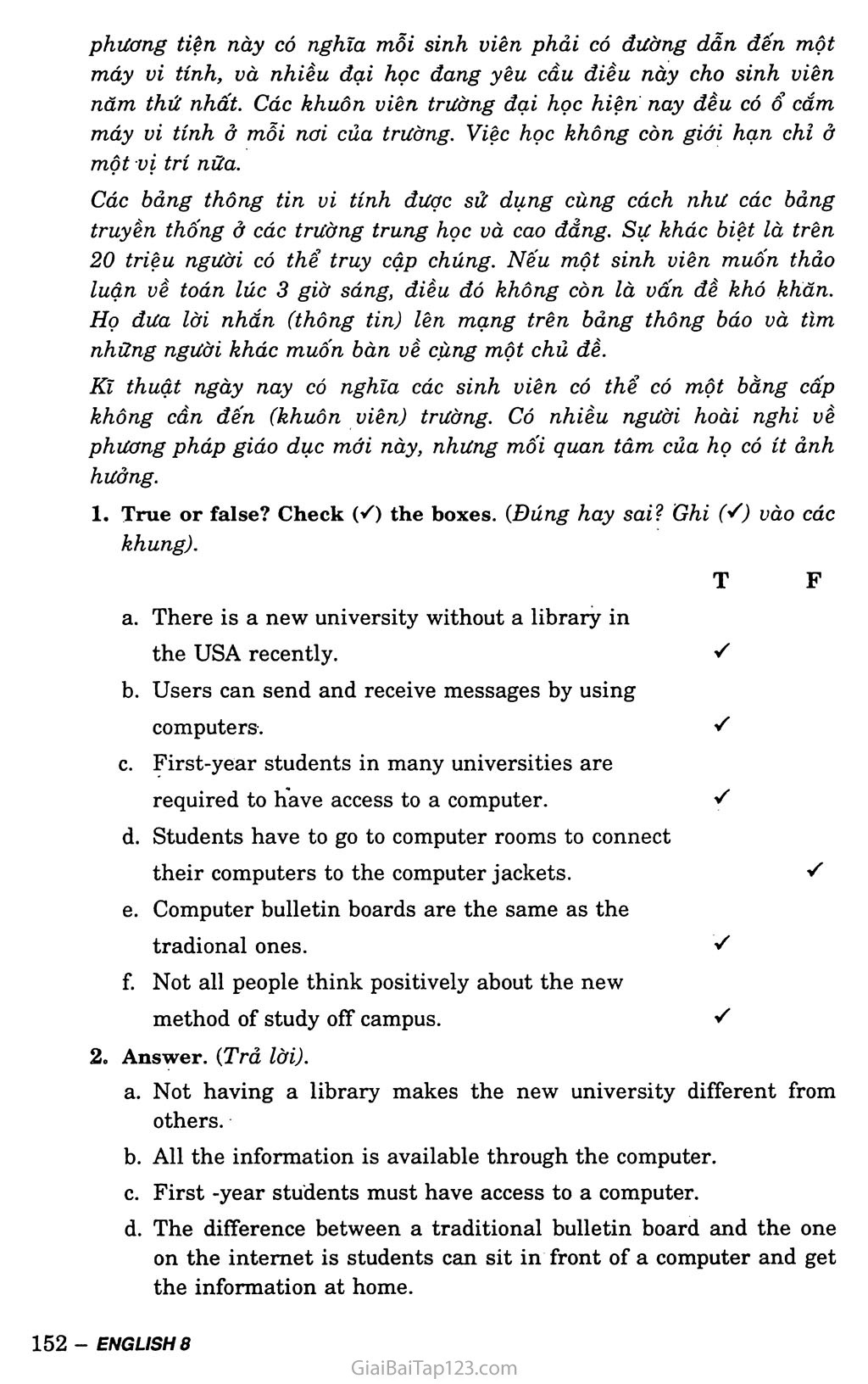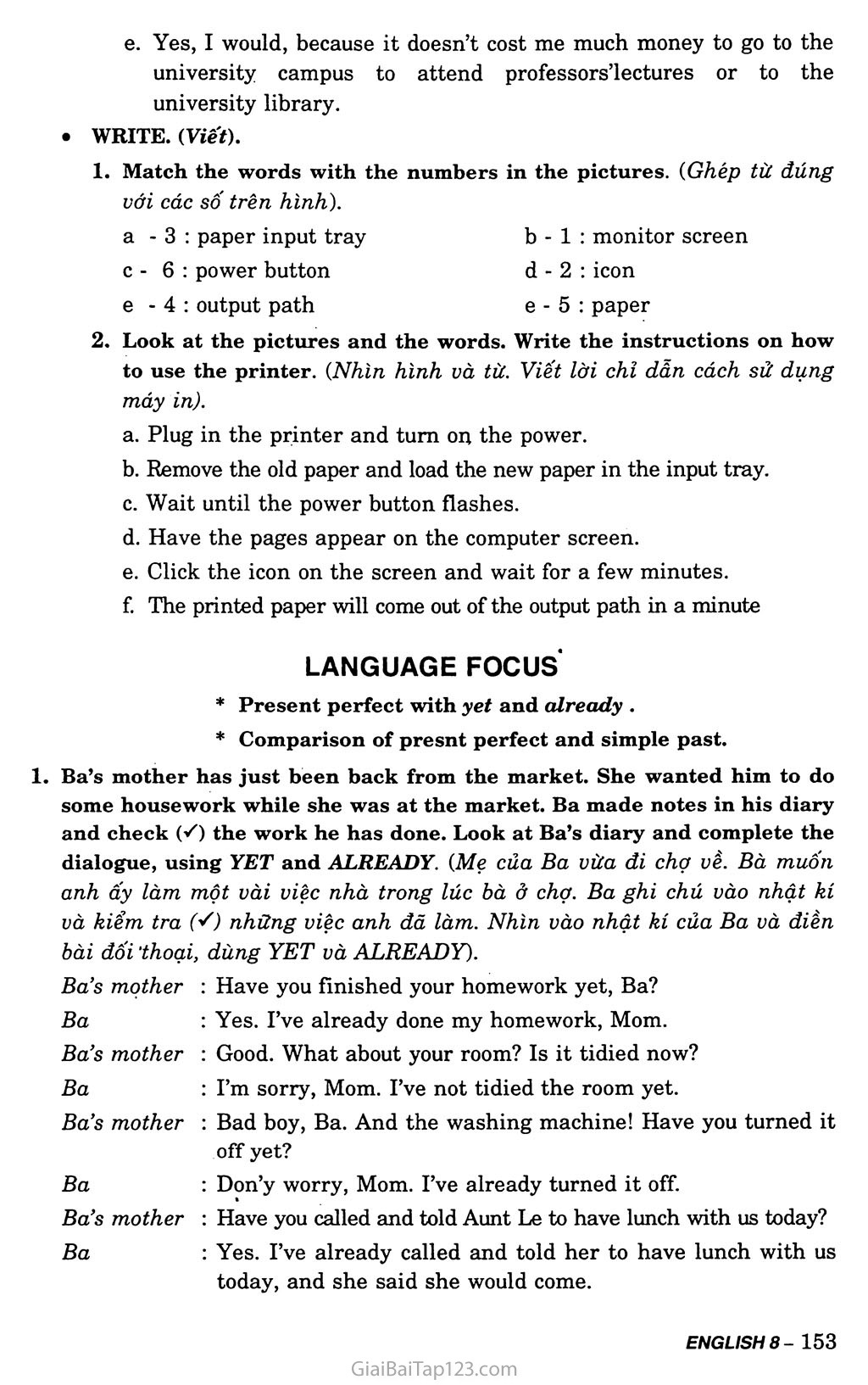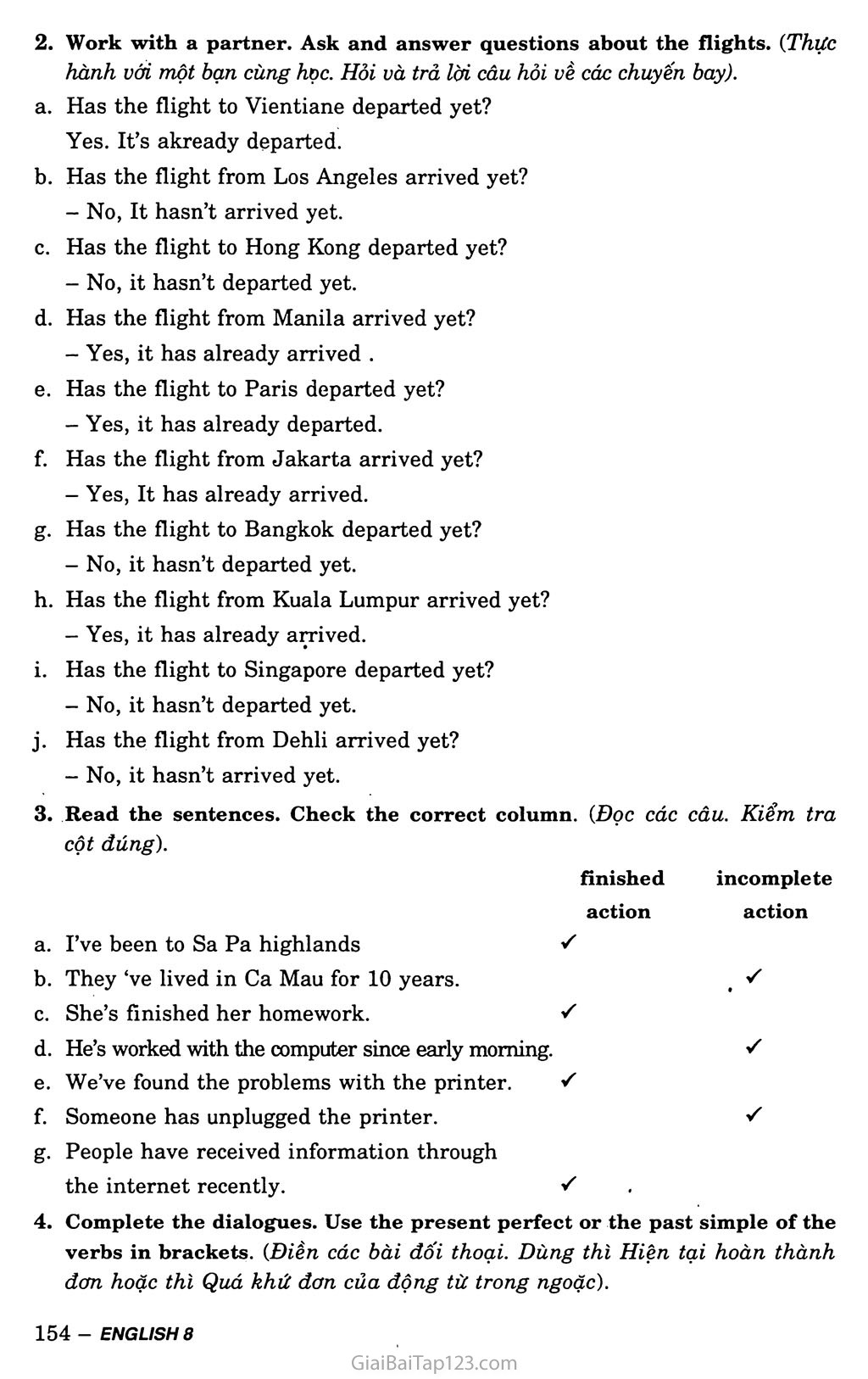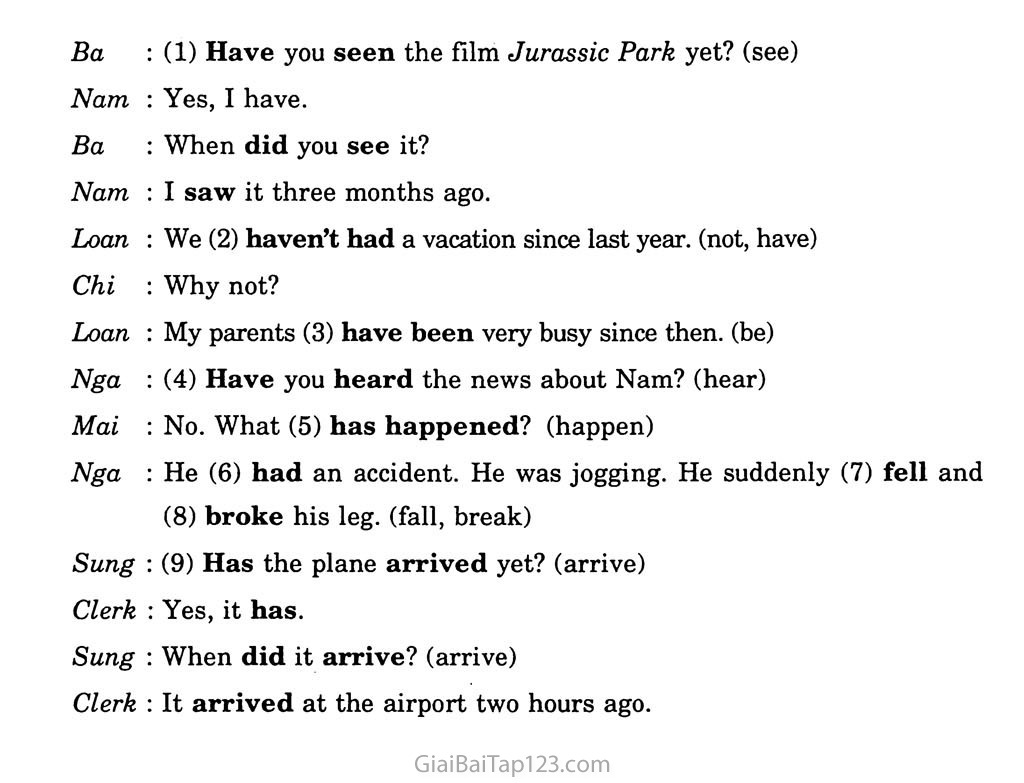Giải tiếng Anh lớp 8 Unit 15: Computers
Unit
15
COMPUTERS
(Máy tính)
I. VOCABULARY
computer
[k8m’pju:ta]
(n)
: máy tính
save
[seiv]
(v)
: tiết kiệm
printer
[‘printe(r)]
(n)
: máy in
connect
[ka’nekt]
(v)
: nối, mắc (nối)
properly
[‘prDpsli]
(adv)
: đúng cách, thích hợp
plug(in)
[plAg]
(n)
: ghim, cái phích
(v)
: ghim / cắm vào ổ điện
+ unplug
[An’plAg]
(v)
: gỡ / tháo ghim điện
socket
[‘sDkit]
(n)
: ổ điện
manual
[‘maenjusl]
(n)
: cẩm nang, sách chỉ dẫn
guarantee
[gaeran’ti:]
(n)
: giấy / sự bảo hành
(v)
: bảo đảm, bảo hành
unnecessary
[An’nessssri]
(adj)
: không cần thiết
/ necessary
(adj)
: cần thiết
consume
[ken’sju:m]
(V)
: tiêu thụ
consumer
[kan’sjmms]
(n)
: người tiêu thụ
time-consuming [‘taim ksnsjuimir]] (adj) : tốn thời gian challenge ['t/aelindỉ] (v) : thách thức
challenging ['tjaelincfeir)] ' (adj) : thách thức
amusing
[a’mjuizio]
(adj)
: vui vẻ, thích thú
agree
[e’gri:]
(V)
:đồng ý
agreement[s’gri:m9nt]
(n)
: sự đồng ý
disagree
[di’ssgri:]
(v)
: không đồng ý
disagreement [di’s3gri:ment] (n)
: sự không đồng ý
solution
[ss’lujn]
(n)
: cách giải quyết, lời giải
solve
[sdIv]
(v)
: deal with : giải quyết
monitor
[‘mDnits] (n)
: bộ phận của máy tính, giống truyền hình
screen
[skri:n]
(n)
: màn hình
adjust
[e’c&Ast]
(v)
: điều chỉnh
knob
[nDb]
(n)
: tay nắm, nút vặn
mouse
[maus]
(n)
: con chuột
flow
[flsu]
(n)
: luồng, lượng chảy
flow chart
[‘flau ựa:t]
(n)
: biểu đồ chuyển động/hành động
insert
[in’s3:t]
(v)
: chèn vào, đặt xen vào
press
[pres]
(v)
: đè, ấn
store
[sto:(r)]
(v)
: lưu trữ, chứa
(telephone) line [lain]
(n)
: (đường dây) điện thoại
means
[mi:nz]
(n)
: phuơng tiện, cách
access
[ek’ses]
(n)
: đường dẫn, quyền sử dụng
have access
to something
(v)
: được quyền sử dụng
e.g.: Students have access to a computer.
{Sinh viển được quyền sử dụng máy tính').
get access to something (v) : tiếp cận
e.g.: Students in big cities can get access to the Internet easily. {.Học sinh thảnh phố lớn có thề tiếp cận Internet dễ dàng).
requirement
[ri’kwaismsnt]
(n)
: lời / sự yêu cầu
require
[ri’kaia(r)]
(v)
: yêu cầu, đòi hỏi
freshman
[‘frejmsn]
(n)
: sinh viên năm thứ nhất
campus
[‘kasmpes]
(n)
: khuôn viên trường đại học
jack
[‘cfesek]
(n)
: ổ cắm
restrict
[ri’strikt]
(v)
: giới hạn
restriction
[ri’strikfn]
(n)
: sự giới hạn
restrictive
[n’striktiv]
(adj)
: giới hạn
bulletin board
[‘bolstin bo:d]
(n)
: bảng tin, bảng thông báo
post
[paust]
(v) : đưa thông tin lên mạng
technology
[tek’nDladji]
(n) : kĩ thuật
technological [tekna’lDdjikl]
(adj) : thuộc về kĩ thuật
skeptical
[‘skeptikl]
(adj) : có tính hoài nghi
concern
[kan’s3:n]
(n) : sự quan tâm; (v) quan tâm
impact
[‘impaskt]
(n) : ảnh hưởng, tác động
positively
[‘pDZltlvll]
(adv) : (có tính) tích cực
available [a’veilabl] (adj) : có sẵn
paper input tray [‘peipa input trei] (n) : khai để giấy vào máy
power button
[‘paua bAtn]
(n)
: nút mở điện
icon
[‘aikn] (n) : kí hiệu/ hình nhỏ trên màn hình máy
output path
[aut’put pa:e]
(n)
: lô"i/ đường ra
remove
[ri’mu:v]
(v)
: lấy/ cất đi
load
[laud]
(v)
: chất, đưa / nhập vào
flash
[flaej]
(v)
: chiếu sáng, hiện ra
click
[klik]
(v)
: nhấp
II. GRAMMAR
A. The Simple present perfect tense (Corit’d) {Thì Hiện tại hoàn thành đon - tiếp theo).
Thì hiện tại hoàn thành đơn thường được dùng trong câu có những trạng từ như : ALREADY, YET, EVER, NEVER, JUST.
ALREADY (rồi): được dùng ở câu xác định và được viết giữa HAVE vàP.P.
g.: He’s already done that work. {Anh ấy làm công việc đó rồi.
They have already changed the way of thinking. {Họ thay đổi cách suy nghĩ rồi).
YET (chưa): được dùng ở câu phủ định và nghi vấn.
* Negative sentences (câu phủ định): Yet được viết :
- cuối câu hay mệnh đề. )
e.g.: We haven’t met our form teacher yet.
{Chúng tôi chưa gặp giáo viên chủ nhiệm). He hasn’t finished the homework yet.
{Anh ấy chưa làm xong hài tập ở nhà)..
- ngay sau từ NOT.
e.g.: He hasn’t not yet finished reading the book I lent him. (Anh ấy chưa đọc xong cuốn sách tôi cho anh ấy mượn).
EVER (có khi nào, có bao giờ): chỉ sự kiện từ quá khứ đến hiện tại, thường được dùng ở câu hỏi và đứng sau chủ từ.
e.g.: Have you ever seen a real dragon?
(Có bao giờ anh thấy con rồng thật không?)
Has your brother ever gone abroad?
(Có khi nào anh bạn đi ra nước ngoài không?)
NEVER (không / chưa bao giờ) : chỉ sự việc từ quá khứ đến hiện tại, dùng ở câu xác định và được viết giữa HAVE và p.p.
g.: He has never gone to school late.
(Anh ấy không bao giờ đi học trễ).
These pupils have never told lies.
(Các học sinh này chưa bao giờ nói dối).
JUST (vừa) : chỉ sự kiện vừa xảy ra hay vừa chấm dứt, và được viết giữa HAVE và p.p.
e.g.: Mother has just gone to market. (Mẹ vừa đi chợ).
They have just equipped this school with new computers.
(Họ vừa trang bị máy vi tính cho trường này).
JUST NOW (vừa) : cùng nghĩa với JUST, nhưng được dùng với thì
Quá khứ đơn, và đứng ở cuối câu / mênh đề.
e.g.: Mother went to maket just now. (Mẹ vừa đi chợ).
B. Comparison of simple past and simple present perfect (So sánh Thì quá khứ đơn với Thỉ Hiện tại hoàn thành đơn).
1. a. Simple past : diễn tả sự kiện đã xảy và chấm dứt trong quá khứ hoặc có thời gian xác định, e.g.: Columbus discovered America.
(Columbus khám phá ra châu Mĩ).
This school was built over one hundred years ago (Trường này được xây cách nay hơn 100 năm).
Simple present perfect : diễn tả sự kiện đã xảy ra và vẫn còn tiếp tục hay không rõ thời gian.
e.g.: He has lived in this city. (Anh ấy sống ở thành phố này). We have seen this film. (Chúng tôi dã xem phim này).
a. Simple past', diễn tả sự kiện xảy ra suốt một khoảng thời gian trong quá khứ và đã chấm dứt.
e.g.: My father worked, in this factory for five years. (Now he doesn’t) {Cha tôi đã làm việc ở nhà máy này 5 năm).
Simple present perfect : diễn tả sự việc xảy ra suốt một khoảng thời gian trong quá khứ và còn tiếp tục đến hiện tại.
e.g.: My father has worked in this factory for five years. (Now he’s still working.there).
{Cha tôi làm việc ở nhà máy này (được) 5 năm).
III. SOLUTIONS AND TRANSLATIONS.(Lời giải và Bài dịch).
GETTING STARTED
Work with a partner. Make a list of how computers can help US. (Làm việc với một bạn cùng học. Liệt kê cách máy vi tính có thể giúp chúng ta). — Computers save time.
Computers store much more information.
Computers help to get or send information easily and rapidly.
Computers can keep information safely and long.
LISTEN AND READ. (Nghe và đọc).
Nam
: Ba ơi, máy in không chạy (hoạt động).
Ông Nhật
: Nó mới mà. Không thể có điều gì không ổn với nó được. Con mở điện nó chưa?
Nam
: Dạ, con mở rồi.
Ông Nhật
: Con có kết nôi đúng cách không?
Nam
: Ô, Ba à. Con biết kết nô'i máj' in như thế nào mà.
Ổng Nhật
: Cái ghim điện có rời ổ cắm không?
Nam
: Không, nó đúng mà.
Ông Nhật
: Ba không biết vấn đề là gì đây. Cuốn cẩm nang này không hữu dụng lắm.
Nam
: Ba điện thoại cho cửa hàng ba mua nó đi (?)
Ông Nhật
: Ba điện, nhưng Ba mua nó ở thành phô' Hồ Chí Minh. Ba không biết họ có thể làm gì. Tuy nhiên nó đang được bảo hành do đó công ty sẽ làm điều gì với nó.
Nam
: Bây giờ chúng ta hãy điện thoại cho họ đi.
1. Practice the dialogue with a partner. (Thực hành bài đôi thoại với một bạn cùng học).
2. Fact or opinion? Check (Z) the boxes. (Sự kiện hay ý kiến? Ghi dấu (*0 các khung).
Fact
Opinion
a.The printer isn’t working.
✓
b. There shoudn’t be anything wrong with it.
✓
c. I know how to connect a printer.
✓
d. The manual isn’t very helpful.
✓
e. I bought it in Ho Chi Minh City.
✓
f. I don’t know what they can do.
✓
• SPEAK. (Nói)
Work with a partner. Look at the table and the pictures. Take turns to express and respond to opinions about the activities in the pictures.
(Thực hành với một bạn cùng học. Nhìn vào bảng và các hình và thay phiên hỏi và trả lời các ỷ kiến về các hoạt động trong hình).
A. I think computers are useful B. So do I.
I disagree. I think they are unnecessary.
A. I think driving is difficult.
B. You’re right.
I agree, but if we’re careful, it isn’t a problem.
A. Reading picture-books is interesting.
B. I can’t agree with you. I think it’s time-consuming, c. No, I think it’s entertaining.
A. Running and playing in the rain is much fun.
B. So do I.
c. I think so, too.
A. I don’t like fat and canned food.
B. Neither do I.
c. I can’t agree with you. I think they are not time-consuming but delicious food to prepare.
Read the dialogue. (Đọc bài đối thoại).
Lan : Mình gặp khó khăn với cái máy vi tính của mình.
Ba : Nó bị gì vậy?
Lan : Nó không chạy (hoạt động). Mình nghĩ nó hư.
Ba : Không. Bạn không ghim cắm điện!
Lan : 0! Xin lỗi nhé.
Now make similar dialogues about these items. Use the information in the table in exercise 1. (Bây giờ thực hiện những bài đối thoại tương tự về những đồ vật này. Sử dụng thông tin trong bản ở Bài tập 1).
Nam : I’m having problems with my printer.
Ba : What’s wrong?
Nam : It doesn’t print. I think it’s broken.
Ba No. You didn’t turn it on.
Nam : Oh, I’m sorry.
Nga : I’m having problems with my monitor.
Lien : What’s wrong?
Nga : The screen is too dark. I think it’s broken.
Lien : No. I don’t think so. Let me see. You should adjust the knob. Nga : Oh! Thank you. I didn’t know that.
Hoa : I’m having problems with my mouse.
Nam : What’s wrong?
Hoa : It doesn’t work. I think it’s broken.
Nam : Let me see. No. You should check the plug. It can be loose. Now it’s all right.
Hoa : Thanks. You’re very good at it!
LISTEN. (Nghe)
Copy the flow chart into your exercise book. Then listen and complete
it. (Chép biểu đồ hoạt động vào tập bài tập của em. Sau đó nghe và điền nó).
Find a machine —> (a)?
Start
(d)?
<-
i^Soda
LemonSoda
?
ị
?
Insert coins & press button a. Do you have the correct change? c. What do you want to drink?
READ. (Đọc).
Một trường đại học mới không có thư viện vừa khai giảng ở Mĩ. Thông thường tất cả thông tin tỉm thấy ở thư viện này dược lưu trữ ở các máy vi tính của trường. Không rời khỏi máy vi tính, người sử dụng có thể gửi lời nhắn và nhận thông tin qua đường điện thoại. Tuy nhiên,
b. Yes. d. Take it.
phương tiện này có nghĩa mỗi sinh viên phải có đường dẫn đến một máy vi tính, và nhiều đại học đang yêu cầu điều này cho sinh viên năm thứ nhất. Các khuôn viên trường đại học hiện nay đều có ổ cắm máy vi tính ở mỗi nơi của trường. Việc học không còn giới hạn chỉ ở một vị trí nữa.
Các bảng thông tin vi tính được sử dụng cùng cách như các bảng truyền thống ở các trường trung học và cao đẳng. Sự khác biệt là trên 20 triệu người có thể truy cập chúng. Nếu một sinh viên muốn thảo luận về toán lúc 3 giờ sáng, điều đó không còn là vấn đề khó khăn. Họ đưa lời nhắn (thông tin) lên mạng trên bảng thông báo và tìm những người khác muốn bàn về cụng một chủ đề.
Kĩ thuật ngày nay có nghĩa các sinh viên có thể có một bằng cấp không cần đến (khuôn viên) trường. Có nhiều người hoài nghi về phương pháp giáo dục mới này, nhưng mối quan tâm của họ có ít ảnh hưởng.
1. True or false? Check (■/) the boxes. (Đúng hay sai? Ghi (V) vào các khung).
T F
There is a new university without a library in
2= Answer. (Trả lời).
Not having a library makes the new university different from others.
All the information is available through the computer.
First -year students must have access to a computer.
The difference between a traditional bulletin board and the one on the internet is students can sit in front of a computer and get the information at home.
Yes, I would, because it doesn’t cost me much money to go to the university campus to attend professors’lectures or to the university library.
WRITE. (Viết).
Match the words with the numbers in the pictures. (Ghép từ đúng với các số trên hình).
a - 3 : paper input tray
b - 1 : monitor screen
c - 6 : power button
d - 2 : icon
e - 4 : output path
e- 5 : paper
Look at the pictures and the words. Write the instructions on how to use the printer. (Nhìn hình và từ. Viết lời chỉ dẫn cách sử dụng máy in).
Plug in the printer and turn on the power.
Remove the old paper and load the new paper in the input tray.
Wait until the power button flashes.
Have the pages appear on the computer screen.
Click the icon on the screen and wait for a few minutes.
The printed paper will come out of the output path in a minute
LANGUAGE FOCUS
Present perfect with yet and already .
Comparison of presnt perfect and simple past.
Ba’s mother has just been back from the market. She wanted him to do some housework while she was at the market. Ba made notes in his diary and check (•/) the work he has done. Look at Ba’s diary and complete the dialogue, using YET and ALREADY. (Mẹ của Ba vừa đi chợ về. Bà muốn anh ấy làm một vài việc nhà trong lúc bà ở chợ. Ba ghi chú vào nhật kí và kiểm tra (V) những việc anh đã làm. Nhìn vào nhật kí của Ba và điền bài đối 'thoại, dùng YET và ALREADY).
Ba’s mother : Have you finished your homework yet, Ba?
Ba : Yes. I’ve already done my homework, Mom.
Ba’s mother : Good. What about your room? Is it tidied now?
Ba : I’m sorry, Mom. I’ve not tidied the room yet.
Ba’s mother : Bad boy, Ba. And the washing machine! Have you turned it
off yet?
Ba : Don’y worry, Mom. I’ve already turned it off.
Ba’s mother : Have you called and told Aunt Le to have lunch with US today? Ba : Yes. I’ve already called and told her to have lunch with US
today, and she said she would come.
2.
a.
b.
c.
d.
e.
f.
g-
h.
i.
j-
3.
Work with a partner. Ask and answer questions about the flights. {Thực hành vời một bạn cùng học. Hỏi và trả lời câu hỏi về các chuyến bay).
Has the flight to Vientiane departed yet?
Yes. It’s akready departed.
Has the flight from Los Angeles arrived yet?
No, It hasn’t arrived yet.
Has the flight to Hong Kong departed yet?
No, it hasn’t departed yet.
Has the flight from Manila arrived yet?
Yes, it has already arrived .
Has the flight to Paris departed yet?
Yes, it has already departed.
Has the flight from Jakarta arrived yet?
Yes, It has already arrived.
Has the flight to Bangkok departed yet?
No, it hasn’t departed yet.
Has the flight from Kuala Lumpur arrived yet?
Yes, it has already an-ived.
Has the flight to Singapore departed yet?
No, it hasn’t departed yet.
Has the flight from Dehli arrived yet?
No, it hasn’t arrived yet.
Read the sentences. Check the correct column. {Đọc các câu. Kiểm tra cột đúng).
finished incomplete
a.
b.
c.
d.
e.
g-
I’ve been to Sa Pa highlands
They ‘ve lived in Ca Mau for 10 years.
She’s finished her homework.
He’s worked with the computer since early morning. We’ve found the problems with the printer. Someone has unplugged the printer.
People have received information through the internet recently.
action action
✓
✓
✓
✓
✓
✓
✓
Complete the dialogues. Use the present perfect or the past simple of the verbs in brackets. {Điền các bài đối thoại. Dùng thì Hiện tại hoàn thành đơn hoặc thì Quá khứ đơn của động từ trong ngoặc).
Ba : (1) Have you seen the film Jurassic Park yet? (see)
Nam : Yes, I have.
Ba : When did you see it?
Nam : I saw it three months ago.
Loan : We (2) haven’t had a vacation since last year, (not, have)
Chi : Why not?
Loan : My parents (3) have been veiy busy since then, (be)
Nga : (4) Have you heard the news about Nam? (hear)
Mai : No. What (5) has happened? (happen)
Nga : He (6) had an accident. He was jogging. He suddenly (7) fell and (8) broke his leg. (fall, break)
Sung : (9) Has the plane arrived yet? (arrive)
Clerk : Yes, it has.
Sung : When did it arrive? (arrive)
Clerk : It arrived at the airport two hours ago.

